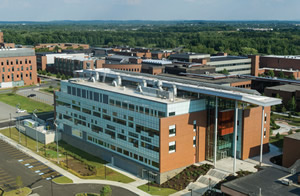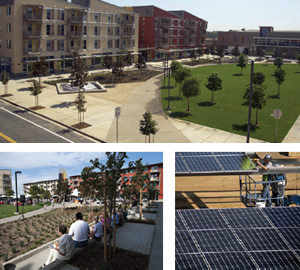Leading the Way in Sustainability
Colleges and universities continue to build innovative, sustainable facilities on campuses across the country.
- By Sherrie Negrea
- 10/01/13

PHOTO COURTESY OF ROCHESTER INSTITUTE OF TECHNOLOGY
Harvard University has 88 certified LEED projects on its campus — more than any higher educational institution in the world. The University of California, Davis (UC Davis) built the largest net-zero energy residential community in the country. And Rochester Institute of Technology offered the first Ph.D. in sustainability relating to industrial manufacturing.
Since the sustainability movement emerged on college campuses in the 1990s, institutions have led by example in the development of green buildings and conservation measures that will reduce their carbon footprint.
Competition is often a factor driving many institutions in their quest for a Platinum certification from the U.S. Green Building Council (USGBC) or a top ranking on The Princeton Review’s Green Rating Honor Roll. Reaching such milestones not only brings recognition to a school but also allows it to take stock of its progress.
“A lot of institutions, in addition to wanting the positive recognition, are looking to know how they’re doing with sustainability on campus,” says Meghan Fay Zahniser, director of programs for the Association for the Advancement of Sustainability in Higher Education (AASHE).
Institutions that have become leaders in the sustainability movement in higher education have reached their goals after developing a long-range vision for their campus, engaging in careful planning and including a diverse range of stakeholders in the process. Here are examples of how four universities — Harvard, UC Davis, the Rochester Institute of Technology (RIT) and the University of Massachusetts Amherst — achieved breakthroughs in the sustainability movement.
Harvard’s LEED Buildings
In 2011, Harvard became the first institution in the world to complete 50 Leadership in Energy and Environmental Design (LEED) certifications for construction projects on its Cambridge and Allston, MA, campuses. Since then, 38 more LEED-certified buildings have been constructed and 23 more are awaiting final designation from the USGBC.
Harvard completed 50 LEEDcertified buildings four years after it created its first Green Building Guidelines, a set of practices that were later revised. The building standards, developed with the input of stakeholders across campus, now apply to any capital project over $100,000.
With a set of detailed building guidelines, Harvard has been able to construct sustainable projects that do not cost significantly more than non-LEED buildings, says Andrea Ruedy Trimble, senior program manager for Harvard Green Building Services. “It really illustrates the potential to achieve high certification levels without any added costs as part of an integrated process,” she says.
Besides focusing on renovation and new construction, Harvard has also reached milestones in Commercial Interiors (CI) LEED certification. In 2006, the university received certification for the nation’s first LEED-CI kitchen, located in an undergraduate house, and in 2010, it completed the first LEED-CI Platinum classroom in the world.
Along with improvements in energy conservation, the green building projects have helped Harvard reduce its greenhouse gas emissions by 16 percent since 2006, despite an additional 3,000,000 square feet of new space on campus.

PHOTOS COURTESY OF UC DAVIS ARM
MIXING IT UP. UC Davis West Village is the largest mixed-use, planned zero-net-energy community in the U.S. It is on track to demonstrate, for the first time, that zero net energy is practical on a large scale
UC Davis’ West Village
Because of climbing housing prices in Davis, CA, UC Davis decided in 2007 to build an affordable and environmentally responsible residential community adjacent to its main campus. By the time West Village broke ground two years later, planners had determined that the development should be built as a net-zero energy community.
“On an annual basis, we wanted the amount of renewable energy produced to be equal to the amount of energy consumed on the grid,” says Sid England, the university’s assistant vice chancellor of Environmental Stewardship and Sustainability.
To achieve that goal, a fourmegawatt photovoltaic system was built to meet the energy needs of the first phase of the project, which includes apartments for 1,980 students, 343 single family homes that will break ground next year and office space for several research units. The university is also building a biodigester that will convert table scraps, animal and plant waste into energy.
Constructing the apartments into clusters around an interior courtyard allows the units to have windows on both sides, which helps draw in the cool air of northern California and eliminate a reliance on air conditioning. In addition, residents of the community must be willing to travel to campus, which is separated from West Village by a state highway, on the bicycle-pedestrian bridge that crosses it, or by bus.
With phase one of the energy-efficient community complete, West Village has attracted hundreds of visitors and has served as a model for a new sustainable city planned on the outskirts of Dubai in the United Arab Emirates.
RIT’s New Sustainable Institute
Years before sustainability became a buzzword, researchers at RIT in upstate New York were working with industry to promote the use of remanufacturing, the process of dissembling equipment and machinery and retrofitting discarded components into new products. As pioneers in this field, RIT decided to create an educational degree in this area and began applying for private and public funding for the program.
The goal was to house the doctoral program in a living lab that would bring together research in a variety of sustainability fields, such as manufacturing, fuel cell development and pollution prevention. Last April, that dream was realized when the $40-million Golisano Institute for Sustainability opened on campus.
Powered by solar panels, a fuel cell, a geothermal system and vertical wind turbines, the 84,000-square-foot building was designed to exceed LEED Platinum standards. The institute houses 110 researchers working on cutting-edge sustainable technology that has already been applied to industries across the globe.
“I tell my colleagues in the academic world that if we don’t work hard to make sure that our discoveries are going out into the field, we become part of the problem, not the solution,” says Nabil Nasr, associate provost and director of the sustainability institute.
Since offering a Ph.D. in sustainability in 2008, 34 students have enrolled in RIT’s doctoral program and five have earned their degrees. The program offers multiple tracks in energy systems, sustainability mobility and sustainable production.
UMass Amherst Tackles Sustainable Dining
What started out as a student organization at UMass Amherst blossomed in a nationally recognized program in 2012 when the university won first place in the White House College Champions of Change competition. The award honored the UMass Permaculture Initiative, which has transformed underused lawns on campus into low-maintenance vegetable gardens.
Now a campus-wide project, the initiative has created four gardens on campus that generate produce for the university’s dining services. In 2012, students involved in the project also launched the annual UMass Permaculture Your Campus Conference, attracting students from around the world interested in permaculture, an ecological design science that can transform property on campuses and communities into sustainable landscapes.
Students were also the driving force in encouraging the university’s chancellor, Kumble R. Subbaswamy, to sign the Real Food Challenge Commitment, which encourages colleges and universities to shift their food budgets toward locally based, fair, ecologically sound and human food sources by 2020. Last April, UMass Amherst, which serves 40,000 meals a day, agreed to work toward using sustainable food for at least 20 percent of its dining purchasing within the next seven years.
The involvement of students in projects like the Real Food Challenge is central to the university’s sustainability goals, says Ezra Small, the campus sustainability manager. The creation of such student-led sustainability initiatives led UMass Amherst to be recognized as one of 22 colleges that received the highest possible score on The Princeton Review’s 2014 Green Rating Honor Roll.
“It’s important that we improve our physical campus, and we’ve done a great job with that with our master plan and climate action plan, but the reason we’re here is for our students,” Small says. “The key is to turn that into an opportunity to use our campus as a living laboratory and educate students with the skills they need to be sustainability leaders in the world once they leave here.”
This article originally appeared in the College Planning & Management October 2013 issue of Spaces4Learning.